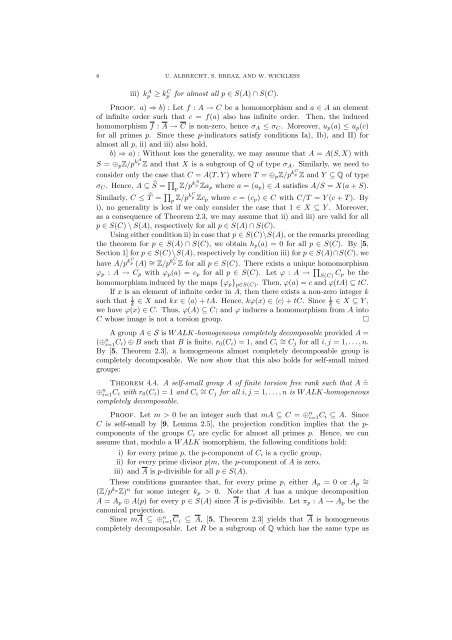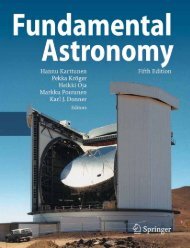Self-small Abelian Groups
Self-small Abelian Groups
Self-small Abelian Groups
You also want an ePaper? Increase the reach of your titles
YUMPU automatically turns print PDFs into web optimized ePapers that Google loves.
8 U. ALBRECHT, S. BREAZ, AND W. WICKLESS<br />
iii) k A p ≥ k C p for almost all p ∈ S(A) ∩ S(C).<br />
Proof. a) ⇒ b) : Let f : A → C be a homomorphism and a ∈ A an element<br />
of infinite order such that c = f(a) also has infinite order. Then, the induced<br />
homomorphism f : A → C is non-zero, hence σA ≤ σC. Moreover, up(a) ≤ up(c)<br />
for all primes p. Since these p-indicators satisfy conditions Ia), Ib), and II) for<br />
almost all p, ii) and iii) also hold.<br />
b) ⇒ a) : Without loss the generality, we may assume that A = A(S, X) with<br />
S = ⊕pZ/p kA p Z and that X is a subgroup of Q of type σA. Similarly, we need to<br />
consider only the case that C = A(T, Y ) where T = ⊕pZ/p kC p Z and Y ⊆ Q of type<br />
σC. Hence, A ⊆ S = <br />
p Z/pkA p Zap where a = (ap) ∈ A satisfies A/S = X(a + S).<br />
Similarly, C ≤ T = <br />
p Z/pkC p Zcp where c = (cp) ∈ C with C/T = Y (c + T ). By<br />
i), no generality is lost if we only consider the case that 1 ∈ X ⊆ Y . Moreover,<br />
as a consequence of Theorem 2.3, we may assume that ii) and iii) are valid for all<br />
p ∈ S(C) \ S(A), respectively for all p ∈ S(A) ∩ S(C).<br />
Using either condition ii) in case that p ∈ S(C)\S(A), or the remarks preceding<br />
the theorem for p ∈ S(A) ∩ S(C), we obtain hp(a) = 0 for all p ∈ S(C). By [5,<br />
Section 1] for p ∈ S(C)\S(A), respectively by condition iii) for p ∈ S(A)∩S(C), we<br />
have A/p kC<br />
p (A) ∼ = Z/p kC<br />
p Z for all p ∈ S(C). There exists a unique homomorphism<br />
ϕp : A → Cp with ϕp(a) = cp for all p ∈ S(C). Let ϕ : A → <br />
S(C) Cp be the<br />
homomorphism induced by the maps {ϕp} p∈S(C). Then, ϕ(a) = c and ϕ(tA) ⊆ tC.<br />
If x is an element of infinite order in A, then there exists a non-zero integer k<br />
such that 1<br />
1<br />
k ∈ X and kx ∈ 〈a〉 + tA. Hence, kϕ(x) ∈ 〈c〉 + tC. Since k ∈ X ⊆ Y ,<br />
we have ϕ(x) ∈ C. Thus, ϕ(A) ⊆ C; and ϕ induces a homomorphism from A into<br />
C whose image is not a torsion group. <br />
A group A ∈ S is W ALK-homogeneous completely decomposable provided A =<br />
(⊕ n i=1 Ci) ⊕ B such that B is finite, r0(Ci) = 1, and Ci ∼ = Cj for all i, j = 1, . . . , n.<br />
By [5, Theorem 2.3], a homogeneous almost completely decomposable group is<br />
completely decomposable. We now show that this also holds for self-<strong>small</strong> mixed<br />
groups:<br />
Theorem 4.4. A self-<strong>small</strong> group A of finite torsion free rank such that A . =<br />
⊕ n i=1 Ci with r0(Ci) = 1 and Ci ∼ = Cj for all i, j = 1, . . . , n is W ALK-homogeneous<br />
completely decomposable.<br />
Proof. Let m > 0 be an integer such that mA ⊆ C = ⊕ n i=1 Ci ⊆ A. Since<br />
C is self-<strong>small</strong> by [9, Lemma 2.5], the projection condition implies that the pcomponents<br />
of the groups Ci are cyclic for almost all primes p. Hence, we can<br />
assume that, modulo a W ALK isomorphism, the following conditions hold:<br />
i) for every prime p, the p-component of Ci is a cyclic group,<br />
ii) for every prime divisor p|m, the p-component of A is zero,<br />
iii) and A is p-divisible for all p ∈ S(A).<br />
These conditions guarantee that, for every prime p, either Ap = 0 or Ap ∼ =<br />
(Z/p kp Z) n for some integer kp > 0. Note that A has a unique decomposition<br />
A = Ap ⊕ A(p) for every p ∈ S(A) since A is p-divisible. Let πp : A → Ap be the<br />
canonical projection.<br />
Since mA ⊆ ⊕ n i=1 Ci ⊆ A, [5, Theorem 2.3] yields that A is homogeneous<br />
completely decomposable. Let R be a subgroup of Q which has the same type as
















